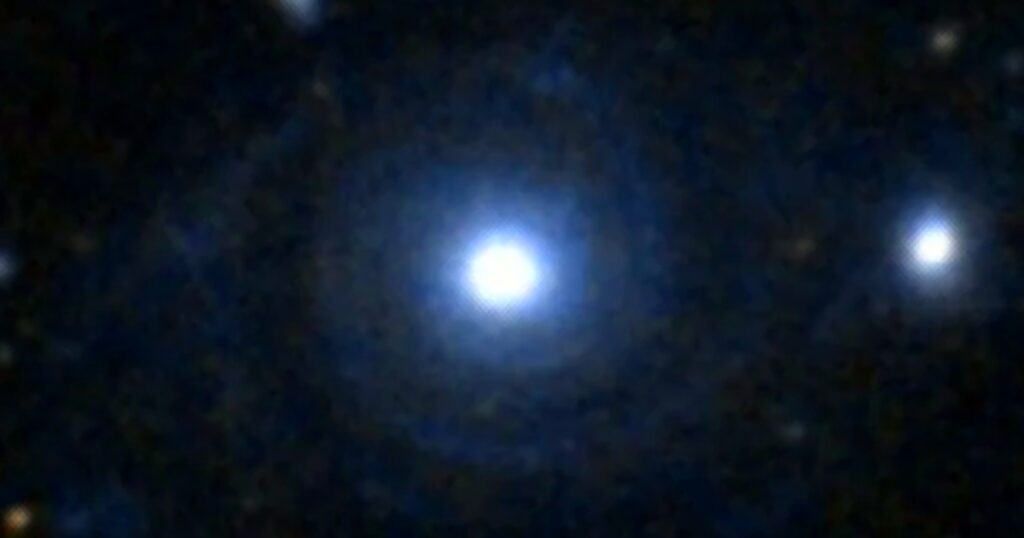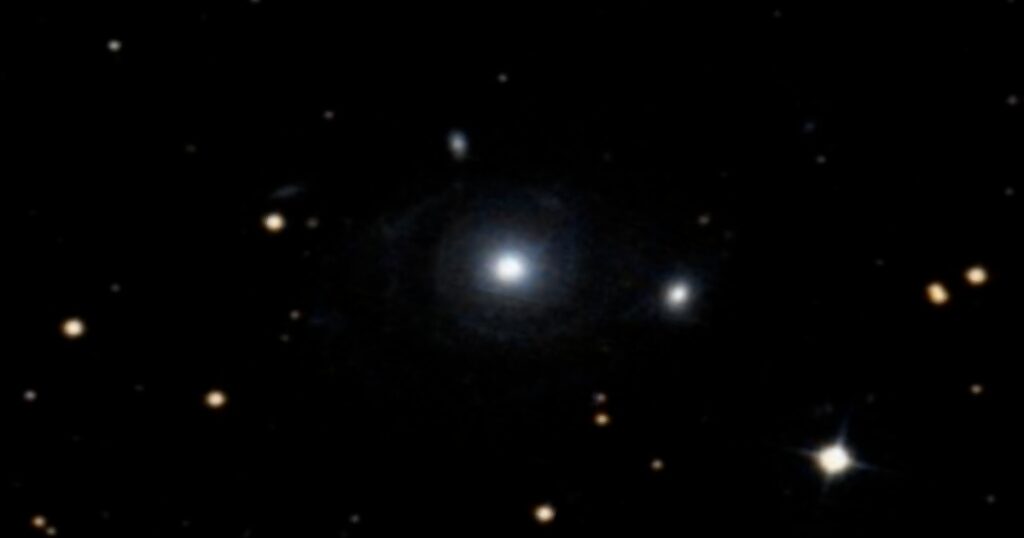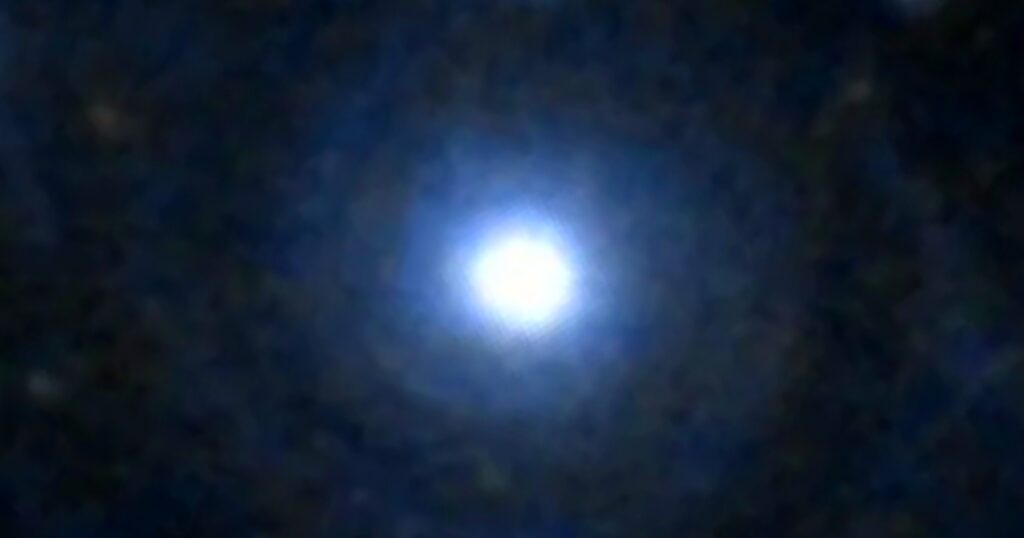NGC 262 Nebula – Largest Nebula Ever is a cosmic colossus. Located approximately 287 million light-years away in the constellation Andromeda, it surrounds one of the largest spiral galaxies called NGC 262 Galaxy. NGC 262 Nebula boasts a staggering size.
While nebulae come in various shapes and sizes, NGC 262 stretches across an amazing distance, estimated to be over 1 million light-years in diameter. To put that into perspective, our entire Milky Way galaxy, with its billions of stars and vast interstellar dust lanes, measures roughly 100,000 light-years across.
So, NGC 262 could easily encompass ten Milky Ways within its gaseous embrace. NGC 262 Nebula is the leftover material from smaller galaxies merging with the central spiral NGC 262 galaxy.

Estimates suggest this colossal nebula possesses a mass of approximately 50 billion times that of our Sun. Imagine the sheer amount of raw material, hydrogen gas, dust particles, and trace elements, swirling within this cosmic cloud, waiting to be sculpted by gravity and birth new stellar generations.
What is the Shape & Structure of NGC 262 Nebula?
Unlike some nebulae that appear as wispy, ethereal clouds, NGC 262 possesses a distinct, almost majestic structure. Astronomers classify it as a spiral nebula, with long, winding arms emanating from a central core. This spiral structure hints at the dynamic processes taking place within the nebula.
As gravity pulls the vast gas and dust cloud inward, it doesn’t simply collapse uniformly. Instead, the material acquires angular momentum, causing it to rotate and form the characteristic spiral arms. These arms become the densest regions within the nebula, prime locations for star formation.
The exact origin of NGC 262’s spiral structure remains a topic of ongoing research. Some theories suggest that the nebula might have been influenced by tidal interactions with smaller galaxies in the past. These gravitational tugs could have nudged the gas and dust cloud, setting it into rotation and triggering the formation of the spiral arms.
What is the Origin of NGC 262 Nebula?
The origin story of NGC 262’s vast reservoir of gas and dust remains an unsolved mystery. One theory suggests that the nebula’s material might be the leftover debris from the collision and merger of smaller galaxies in the distant past.
The immense gravitational forces unleashed during such mergers could have ripped apart these galaxies, flinging vast quantities of gas and dust into the intergalactic space, where they eventually coalesced to form NGC 262.
Another possibility is that NGC 262 represents a vast filament of gas and dust that existed even before the formation of the galaxies we see today. These primordial filaments, woven throughout the early universe, might have served as the building blocks for the formation of galaxies and their associated nebulae like NGC 262.
When and Who Discovered NGC 262 Nebula?
The credit for finding this celestial giant goes to American astronomer Lewis A. Swift. On September 17th, 1885, Swift, a prolific observer known for discovering numerous comets and nebulae, trained his telescope toward the constellation Andromeda.
During his observations, he stumbled upon a faint, yet extensive, cloud of gas and dust, cataloging it as NGC 262 within the New General Catalogue (NGC), a comprehensive index of astronomical objects.
Little did Swift know at the time that he had just unveiled the largest known nebula in the universe. The true scale of NGC 262’s magnificence wouldn’t be fully appreciated until the advent of more powerful telescopes and sophisticated astronomical techniques in the following decades.

What is NGC 262 Nebula’s Distance from Earth?
NGC 262 Nebula is located approximately 287 million light-years away from Earth in the constellation Andromeda, it surrounds one of the largest spiral galaxies called NGC 262 Galaxy.
What is the Size of NGC 262 Nebula?
NGC 262 boasts a staggering size, estimated to be over 1 million light-years in diameter.
What is the Mass of NGC 262 Nebula?
The estimated mass of NGC 262 is approximately 9.945 x 10^40 kilograms, which is 50 billion times more massive than our Sun.
NGC 262, A Stellar Nursery:
The true significance of NGC 262 lies in its role as a stellar nursery. Within the dense pockets of gas and dust nestled within its spiral arms, gravity takes center stage. As the gas clumps together, the pressure and temperature at the core of these clumps begin to rise.
Eventually, these stellar embryos reach a critical point where nuclear fusion ignites, marking the birth of a new star.
Observations of NGC 262 reveal the presence of numerous young, hot stars embedded within its dusty embrace. These newborn stars bathe the surrounding gas and dust in intense ultraviolet radiation, sculpting the nebula and triggering further star formation in a domino effect.
This cycle of birth, growth, and death of stars within NGC 262 ensures a constant renewal of material and the continued creation of new stellar generations.
The Ongoing Exploration of NGC 262 Nebula:
Early observations provided astronomers with a basic understanding of the nebula’s location and morphology. However, advancements in telescope technology have revolutionized our ability to study NGC 262 in greater detail.
Ground-based telescopes with advanced cameras have captured stunning visuals of the nebula, revealing its intricate spiral structure and the embedded young stars. However, the true power of studying NGC 262 lies in space-based observatories. Unobstructed by Earth’s atmosphere, these telescopes can gather much sharper and clearer observations.
The Hubble Space Telescope, launched in 1990, has been instrumental in providing detailed views of NGC 262. Hubble’s observations have allowed astronomers to study the processes of star formation within the nebula’s dense pockets and analyze the composition of the gas and dust.
Additionally, advanced space telescopes like the James Webb Space Telescope, with its infrared capabilities, promise to unlock even deeper secrets about NGC 262’s composition and the nature of the stellar nurseries it harbors.

NGC 262 Nebula – Largest Nebula Ever as compared to Alcyoneus Galaxy – Largest Galaxy Ever:
NGC 262 Nebula Vs. Alcyoneus Galaxy
| Feature | NGC 262 Nebula (Largest Nebula Ever) | Alcyoneus Galaxy (Largest Galaxy Ever) |
|---|---|---|
| Object Type | Nebula | Galaxy |
| Size | Over 1 million light-years in diameter (largest known nebula) | 16 million light-years (including radio lobes) |
| Distance | Approximately 287 million light-years | Approximately 2.7 billion light-years |
| Location | Andromeda constellation | Located outside our galaxy in the Virgo Supercluster |
| Composition | Primarily hydrogen gas, dust particles, and trace elements | Primarily stars, gas, dust, and dark matter |
| Function | Stellar nursery (birthplace of stars) | Collection of billions of stars, gas, dust, and dark matter |
| Discovery | 1885 by Lewis A. Swift | 2018 by University of Hawaii astronomers |
Future of NGC 262 Nebula:
The future of NGC 262 is intricately linked to the ongoing cycle of star birth and death within its gaseous embrace. As the young, hot stars continue to burn brightly, they will eventually reach the end of their stellar lives.
Depending on their mass, they might explode in dramatic supernovae, enriching the surrounding gas and dust with heavier elements forged in their cores. These heavier elements, like carbon, oxygen, and iron, become the building blocks for future generations of stars and planetary systems within NGC 262.
Over vast stretches of time, NGC 262 will continue to be a dynamic environment of star formation. The nebula’s immense reservoir of gas and dust ensures a constant supply of material for new stars to be born.
However, the rate of star formation might not remain constant throughout NGC 262’s lifetime. As the most massive stars exhaust their fuel reserves and explode, they can trigger shockwaves that sweep through the nebula, disrupting the gas clouds and potentially hindering further star formation.
Significance of NGC 262 Nebula:
The discovery and ongoing study of NGC 262 hold immense significance for our understanding of the universe. This colossal nebula serves as a window into the processes of star formation, a fundamental element in galactic evolution.
By studying NGC 262, we gain insights into the birthplaces of stars, the very objects that illuminate our night sky and power the development of planetary systems.
Furthermore, NGC 262’s sheer size and estimated mass challenge our current understanding of nebula formation. Its existence pushes the boundaries of what we thought possible and compels astronomers to refine their theoretical models for the formation and evolution of these celestial giants.
As we delve deeper into the mysteries of NGC 262, we not only unlock the secrets of a single nebula but also gain a broader perspective on the grand narrative of star birth and galactic evolution throughout the cosmos.
Conclusion:
The exploration of NGC 262 is a testament to our ongoing quest to understand the universe we inhabit. With each new observation and discovery, we inch closer to unraveling the mysteries of these magnificent cosmic clouds and the awe-inspiring processes of star formation that take place within them.
As we continue to explore the vast expanse of space, NGC 262 stands as a reminder of the wonders that lie beyond our own galaxy, waiting to be unraveled.
